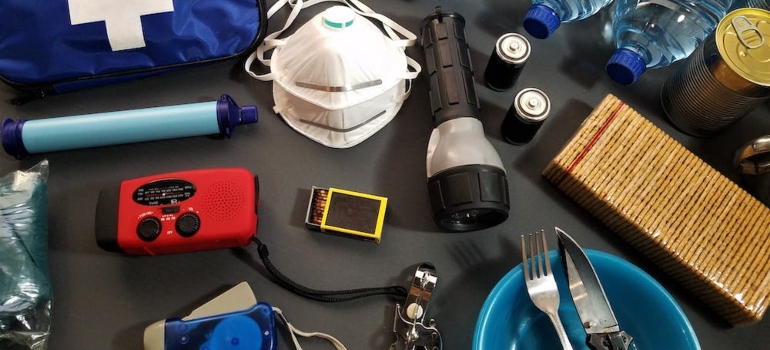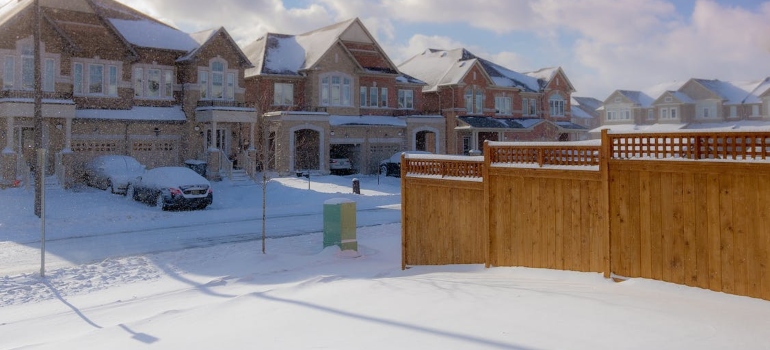Winters in the tri-state area can get really tough. In order to get ready for the tri-state area winters you will need to take many practical measures as well as some personal adjustments. Good preparation will leave you with no worries about the upcoming winter. The tri-state area is made up of the states of New York, New Jersey, and Connecticut. Since it is located further north in the U.S. you can almost always expect a cold winter here. This is why you need to come prepared. Especially if you are moving from a state with a warm climate such as Texas. Luckily for you, we made a reliable guide to help you out. Preparing both yourself and your home for the winter will make a significant difference. Dressing accordingly for the winter and stocking up on supplies will also prove to be useful. We will talk about all of this in the article down below. Let’s see what the state to state movers Texas prepared for you.
Preparing for the tri-state area winters in the best way possible
The first thing to have in mind when moving from Texas to the tri-state area is the difference in the climate. Understanding the difference between these two parts of the nation will help you prepare better. Texas is often drier than the tri-state region, particularly in the state’s western region, which occasionally experiences drought conditions. On the other side, the tri-state region has greater annual rainfall and sporadic, significant winter snowfall. Winters are frigid and summers are hot in the tri-state area, which undergoes dramatic seasonal fluctuations. Contrarily, Texas has a more gradual change in seasons, with a long summer and a milder, shorter winter. This is why cross country movers Dallas insist on good preparation. There is a big difference between winters in Texas and winters in the tri-state area.
What can you do to get ready for the tri-state area winters?
There are many ways to prepare for a winter in the tri-state area. As we mentioned previously, the main things you will be focusing on are practical measures and personal adjustments. Practical measures involve the preparation of your home for the winter and overall safety measures. Personal adjustments are especially important since you are moving here from a very different state climate-wise. All things considered, follow this guide and you will be good to go.
Preparing your home for the winter
It’s crucial to get your heating system checked by a professional before the winter months start. They may check that your boiler or furnace is operating properly and repair any worn or broken parts. Insulation done right may lower energy costs and keep your house comfortable. Verify the insulation levels in your attic, walls, and flooring. To stop drafts, you may also place weather stripping around windows and doors. Make sure your smoke and carbon monoxide alarms are operational and change any low batteries.

Stop cold air from entering your house by filling in any gaps or crevices around your doors, windows, and pipes. You can cover these gaps by using caulking, weather-stripping, or spray foam insulation. Make sure to stop exposed pipes from freezing and exploding by insulating them. Use heat tape or foam pipe insulation to safeguard your pipes.
Stocking up on supplies
Make a list of all the necessities you’ll require in the event of a winter storm, including non-perishable food, bottled water, batteries, candles, blankets, and a first aid kit. Make sure you have at least three days’ worth of non-perishable food on hand. Items like canned products, dried fruits and nuts, and quick noodles may fall under this category. A gallon of water per person every day is also recommended. You’ll also want emergency supplies like flashlights, batteries, a battery-powered radio, and a first-aid kit in addition to food and water. Make that you have adequate supplies for every household member.

If your neighborhood frequently loses electricity, you might want to buy a backup generator or a portable power bank for your electrical gadgets. Make sure your automobile emergency kit is up to date and has supplies like blankets, a shovel, a flashlight, and a first aid kit if you have a car. To make sure you always have fresh goods on hand, double-check the expiration dates on all the things you buy and rotate them on a regular basis.
Dressing appropriately
One of the biggest differences between living in Texas and living in the tri-state area is dressing up. Especially for the colder months of the year. There are several good ways to dress up properly for the winter here. To keep warm air near your body, layer your clothing. Start with a base layer that wicks away moisture, add an insulating mid-layer, and finish with a waterproof upper layer to fend off wind and precipitation. Because the head loses a lot of body heat, it’s crucial to wear a thick hat to protect your head and ears from the cold. Your face and neck can stay warm while being protected from the wind and snow with a scarf or neck gaiter. Look for materials like wool, down, fleece, and synthetic textiles like Gore-Tex that are made to keep you warm and dry.
How to deal with the snow in the winter
The winters in the tri-state area are known for the amounts of snow they bring with them. If you live in a house, at one point, you will surely need to deal with the snow. Here are some ways to do it.
- During and after a blizzard, shovel often to keep the snow from building up. Employ a good snow shovel, and pause if necessary.
- Snow and ice on pathways and driveways may be melted with the use of salt or sand, making shoveling easier. Follow the usage directions carefully, and don’t use too much since this might harm concrete and plants.
- A snow blower might be a smart purchase if you live in a region that experiences frequent snowfall. Choose a model that is appropriate for your needs, and be sure to use it safely.
- Driving on snow and ice may be dangerous. Drive carefully, give other drivers plenty of room, and be ready for unexpected stops or skids.
Follow these tips to easily deal with the snow in the winter. Now that we are mentioning snow, it is important to note the importance of moving during certain periods of the year. If you plan on moving to the tri-state area during the winter you may encounter problems because of the snow. So, consider hiring interstate movers Houston during the warmer periods of the year to avoid the trouble of moving during bad weather.
Winters in the state of New York
Depending on the area, New York’s winters can vary. With its size and diversity, New York State has a range of climates and topographies that can affect how the wintertime weather behaves. Yet, New York State’s winters are typically recognized for being chilly and snowy. Winters may be exceptionally severe in Upstate New York, which includes the Adirondack Mountains. There are often periods of heavy snowfall and temperatures that plummet well below freezing. In certain places, snowfall that reaches several feet can make travel hazardous and cause power disruptions. Winters in the New York City metropolitan region are less harsh but nonetheless chilly. Normal temperatures vary from the 20s to the 40s, with the possibility of precipitation and freezing rain on occasion.
Winters in the state of New Jersey
New Jersey’s winters can be bitterly cold and snowy, or they can be pleasant with sporadic milder spells. In the northern region of the country, New Jersey has a continental climate with four distinct seasons. The average wintertime temperature in New Jersey is between 20 and 40 degrees Fahrenheit (-4 and 7 degrees Celsius), with sporadic dips below zero (-18 degrees Celsius) in the state’s northern regions. Although the amount of snowfall might vary from year to year, the state normally has numerous snowstorms during the winter.

Power outages, school closings, and difficulties in transportation are all possible effects of heavy snowfall. Due to the moderating influences of the Atlantic Ocean, the coastal regions of New Jersey, including towns like Atlantic City and Cape May, typically experience warmer winters. Winter storms, such as nor’easters, which may bring strong winds and a lot of snow, can still hit coastal areas.
Winters in the state of Connecticut
In Connecticut, winters are frequently chilly and snowy. In the northern region of the country, Connecticut has a continental climate with four distinct seasons. During winter, Connecticut has temperatures that normally range from the low 20s to the mid-30s Fahrenheit (-6°C to 2°C), with sporadic dips below zero Fahrenheit (-18°C) in the state’s northern regions. Although the amount of snowfall might vary from year to year, the state normally has numerous snowstorms during the winter. Due to the moderating influences of the Long Island Sound, the coastal regions of Connecticut, including cities like New Haven and Bridgeport, typically experience milder winters. Winter storms, such as nor’easters, which may bring strong winds and a lot of snow, can still hit coastal areas.
How to get ready for the tri-state area winters when you are moving from Texas
It can be difficult to adjust when moving from Texas to the Tri-State region, especially when it comes to getting ready for the winter. You’ll probably want to invest in warm clothes, such as a thick coat, gloves, a hat, and a scarf. Seek for clothing that is meant to withstand the cold and will keep you dry and comfortable. Boots that are warm, waterproof, and offer grip in snow and ice are also essential. Make sure your automobile is equipped with winter tires, an emergency kit, and a full tank of petrol if you intend to drive throughout the winter.

Always drive cautiously and slowly on the snow and ice. Pay attention to weather reports and get ready for winter storms. Make sure you are aware of how to keep safe during severe weather. We also recommend you thoroughly inform yourself about the weather in this area before you hire out of state movers Austin and move here. Knowing what to expect will make it easier for you to adapt to the weather here.
How to stay warm in your home during winter in the tri-state area
Employ a humidifier because it makes the air more pleasant by adding moisture, which might make you feel warmer. Put draft stoppers at the bottom of your doors to keep the cold out of your house. To keep the chilly air out and the warm air in, use blinds or drapes. Try cooking and baking on your stove or oven to help warm up your house. Another great way to save heating expenses and maintain the warm air in the places you use the most is to close off any underused spaces. The best way to get ready for the tri-state area winters is to do all of this before the actual winter. This is why the interstate movers in San Antonio TX recommend moving into your home before winter, to ensure you have time to set everything up properly.
Get ready for the tri-state area winters by setting up heating and insulation in your new home
There are a few things to consider in the case of moving into a new home without proper insulation or heating. The first thing we recommend doing is installing the heating to ensure warmth in your home during winter. The heating system is your best ally during the winters in the tri-state area.

The second thing is taking care of the insulation in your home. If your home lacks adequate insulation, think about adding additional to the walls, floors, and attic. Both a professional and a do-it-yourself job are options for this. While not in use, the damper on your fireplace should be closed to stop heated air from escaping. Rugs and carpets may help keep your flooring warm by insulating them. To assist move warm air about the room, set the direction of your ceiling fans to revolve clockwise.
Moving from Texas to the tri-state area
Your best allies in a long-distance move such as this one will be professional movers. The best way to get ready for the tri-state area winters is to hire reliable movers in Texas to help you get on your way. When you are properly settled in your new home, all that is left is to follow the simple guide we prepared for you. That was all we prepared for you today. Thank you for reading our article. Good luck with your move and stay safe during winter.
